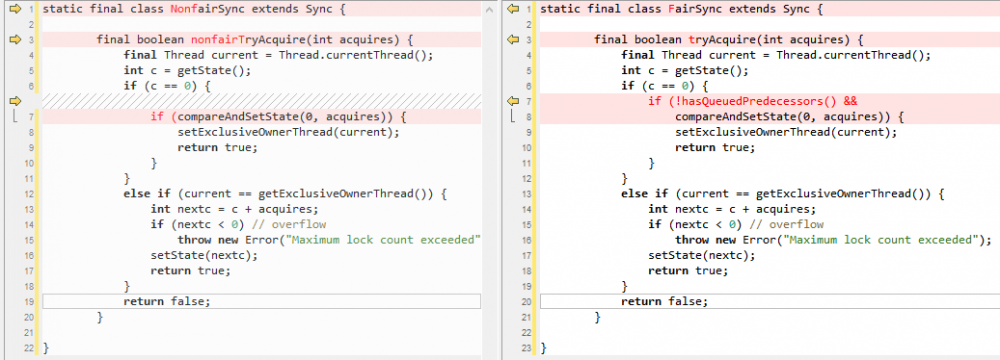小白的 ReentrantLock 源码略谈
ReentrantLock (简称RLock) 是Java的一种锁机制。从API上看,RLock提供了公平锁与非公平锁,并提供了当前锁状态监测的一些接口。其内部是由 FairSync 与 NonFairSync 来实现锁资源的抢占与释放。下面我们来学习下其源码。
从最直白的方法入手
首先我们打开 RLock 的构造函数,源码如下:
private final Sync sync;
public ReentrantLock() {
sync = new NonfairSync();
}
public ReentrantLock(boolean fair) {
sync = fair ? new FairSync() : new NonfairSync();
}
复制代码
好的,很直白,根据入参构造成员变量 Sync。默认为 NonfairSync 。到这里,我们遇到了第一个新概念 Sync 。先按住好奇心,我们先找到 lock() 和 unlock() 源码。如下:
public void lock() {
sync.lock();
}
public void unlock() {
sync.release(1);
}
复制代码
到这里好像有些明白了,RLock更像是对Sync的进一层封装,通过多态来实现不同的锁策略。到这里,我有个疑问,公平锁和非公平锁的策略有何不同呢?那么这样看来,啃透 Sync 是关键。
居高观下
首先我们捋一下 Sync 继承结构。IDEA里鼠标移到类声明上, Ctrl+H 即可清晰看到类的继承结构。

AbstractQueuedSynchronizer
(简称AQS)。这个类是JDK并发包中的锁基类,定义了锁资源获取与释放的框架与基本行为。这个先略过不谈,继续贯彻第一步,从最直白的方法入手。
lock()
我们回忆一下lock的行为,我们调用来获取锁,如果其它线程已抢占到锁资源,当前线程挂起,直到当前线程获取到锁。而且RLock支持重入。 NonfairSync#lock() 与 FairSync#lock() 源码如下:

NonfairSync 先设置了状态位,然后调用了
acquire() 。
FairSync 则直接调用了
acquire() 。那么我们先从
compareAndSetState()
入手,源码如下:
protected final boolean compareAndSetState(int expect, int update) {
return unsafe.compareAndSwapInt(this, stateOffset, expect, update);
}
复制代码
这个函数定义在 AQS 中,用于设置当前lock的状态,unsafe呢,是JDK中非常变态的一个工具类,可以直接操控实例对象所在的内存,同时提供了一些原子操作。具体的后面会再展开介绍,简而言之,这个函数可以理解为:
protected final boolean compareAndSetState(int expect, int update) {
synchronized (this.getClass()) {
if (this.state == expect) {
this.state = update;
return true;
} else {
return false;
}
}
}
复制代码
那么到这里我们好像得到了第一把钥匙: lock.state 为0时,为空闲,而上锁请求会将状态置为1,并且将 exclusiveOwnerThread 设为当前线程。
接下来,我们来看 acquire() 。继续跟踪下去, 的 acquire() 代码如下:
public final void acquire(int arg) {
if (!tryAcquire(arg) &&
acquireQueued(addWaiter(Node.EXCLUSIVE), arg))
selfInterrupt();
}
复制代码
唔,好像看不出来什么东西,那么继续跟下去,先从 tryAcquire 开始, NonfairSync 和 FairSync tryAcquire() 核心代码如下

FairSync 获取锁之前会调用
hasQueuedPredecessors()
源码如下:
/**
* @return {@code true} if there is a queued thread preceding the
* current thread, and {@code false} if the current thread
* is at the head of the queue or the queue is empty
* 两种情况返回 false:1. 当前线程在队头。2. 队列为空
*/
public final boolean hasQueuedPredecessors() {
Node t = tail; // Read fields in reverse initialization order
Node h = head;
Node s;
return h != t &&
((s = h.next) == null || s.thread != Thread.currentThread());
}
复制代码
那么我们拿到了第二把钥匙: 公平锁在获取锁之前会先去查询是否有其他人在等待这把锁,如果没有,再尝试获取。而非公平锁则不会询问
这么看来,公平锁 Peace&Love,像民谣,多愁善感,与世无争。而非公平锁 Aggressive,像Hip-Hop,张扬自我,锐意进取。 那么回到 acquire() ,还有一个函数: acquireQueued() ,源码如下:
final boolean acquireQueued(final Node node, int arg) {
boolean failed = true;
try {
boolean interrupted = false;
for (;;) {
final Node p = node.predecessor();
if (p == head && tryAcquire(arg)) {
setHead(node);
p.next = null; // help GC
failed = false;
return interrupted;
}
if (shouldParkAfterFailedAcquire(p, node) &&
parkAndCheckInterrupt())
interrupted = true;
}
} finally {
if (failed)
cancelAcquire(node);
}
}
复制代码
忽略其他细节,我们在 parkAndCheckInterrupt() 函数中找到了 LockSupport.park(this); 。就是他了!这个函数会将指定线程挂起,直至 LockSupport.unpark(Thread) 被调用或者发生意外被操作系统 interrupt 。 至此, lock() 的链便通了。
我们再来总结一下:*** ReentrantLock 在上锁时,会根据实例化时指定的策略去获取锁,默认为非公平锁。如果上锁成功,锁状态值+1(重入,最大次数为 Integer.MAX_VALUE ),并将锁持有者设置为当前线程实例。在 Sync 内部维护了一个队列,存放了所有上锁失败的线程。公平锁在上锁前,会检查在自己前面是否还有其他线程等待,如果有就放弃竞争,继续等待。而非公平锁会抓住每个机会,不管是否前面是否还有其它线程等待,只顾上锁***
unlock()
至于锁释放,公平锁与非公平锁的行为就一样了。核心代码如下
// ReentrantLock#unlock() 释放锁资源
public void unlock() {
sync.release(1);
}
// Sync#release()
public final boolean release(int arg) {
// 重入锁,状态计数器减一,为0时释放
if (tryRelease(arg)) {
Node h = head;
// 释放锁时,从等待队列中获取线程并尝试唤醒
if (h != null && h.waitStatus != 0)
unparkSuccessor(h);
return true;
}
return false;
}
// Sync#tryRelease() 状态计数器减一,为0时,释放锁资源,返回true
protected final boolean tryRelease(int releases) {
int c = getState() - releases;
if (Thread.currentThread() != getExclusiveOwnerThread())
throw new IllegalMonitorStateException();
boolean free = false;
if (c == 0) {
free = true;
setExclusiveOwnerThread(null);
}
setState(c);
return free;
}
// Sync#unparkSuccessor() 唤醒等待队列中的线程,让他(们)继续抢占锁
private void unparkSuccessor(Node node) {
int ws = node.waitStatus;
if (ws < 0)
compareAndSetWaitStatus(node, ws, 0);
Node s = node.next;
if (s == null || s.waitStatus > 0) {
s = null;
// 上锁时向队列尾部添加元素时,可能会导致队列处在中间状态,再从尾部遍历一次
for (Node t = tail; t != null && t != node; t = t.prev)
if (t.waitStatus <= 0)
s = t;
}
// boomya,合适的线程找到啦,将其唤醒
if (s != null)
LockSupport.unpark(s.thread);
}
复制代码
总结一下: 线程在释放锁时,将状态计数器减一(重入),当状态计数器为0时,锁可用。此时再从等待队列中寻找合适的线程唤醒,默认从队首开始,如果队列正在更新中,且未找到合适的线程,那么从队尾开始寻找。











![[HBLOG]公众号](https://www.liuhaihua.cn/img/qrcode_gzh.jpg)

